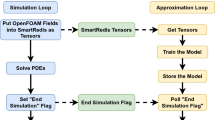Abstract
Hydraulic solvers for the simulation of flows and pressures in water distribution systems (WDS) are used extensively, and their computational performance is key when considering optimization problems. This paper presents an approach to speedup the hydraulic solver using OpenMP with two efficient methods for WDS simulation. The paper identifies the different tasks carried out in the simulation, showing their contribution to the execution time, and selecting the target tasks for parallelization. After describing the algorithms for the selected tasks, parallel OpenMP versions are derived, with emphasis on the task of linear system update. Results are presented for four different large WDS models, showing considerable reduction in computing time.

Similar content being viewed by others
References
Abraham E, Stoianov I (2015) Efficient preconditioned iterative methods for hydraulic simulation of large scale water distribution networks. Proc Eng 119:623–632
Abraham E, Stoianov I (2015) Sparse null space algorithms for hydraulic analysis of large-scale water supply networks. J Hydraul Eng. doi:10.1061/(ASCE)HY.1943-7900.0001089
Alonso JM, Alvarruiz F, Guerrero D et al (2000) Parallel computing in water network analysis and leakage minimization. J Water Resour Plan Manag 126(4):251–260
Alvarruiz F, Martínez-Alzamora F, Vidal AM (2015) Efficient simulation of water distribution systems using openmp. In: 15th International conference computational and mathematical methods in computational mathematics, science and engineering, pp 125–129
Alvarruiz F, Martínez-Alzamora F, Vidal AM (2015) Improving the efficiency of the loop method for the simulation of water distribution systems. J Water Resour Plan Manag 141(10):04015019
Burger G, Sitzenfrei R, Kleidorfer M, Rauch W (2015) Quest for a new solver for EPANET 2. J Water Resour Plan Manag. doi:10.1061/(ASCE)WR.1943-5452.0000596
Creaco E, Franchini M (2014) Comparison of Newton–Raphson global and loop algorithms for water distribution network resolution. J Hydraul Eng 140(3):313–321
Creaco E, Franchini M (2015) The identification of loops in water distribution networks. Proc Eng 119:506–515 Computing and Control for the Water Industry (CCWI2015) Sharing the best practice in water management
Crous PA, van Zyl JE, Roodt Y (2012) The potential of graphical processing units to solve hydraulic network equations. J Hydroinf 14:603–612
Elhay S, Simpson A, Deuerlein J, Alexander B, Schilders W (2014) Reformulated co-tree flows method competitive with the global gradient algorithm for solving water distribution system equations. J Water Resour Plan Manag 140(12):04014040
Epp R, Fowler AG (1970) Efficient code for steady-state flows in networks. J Hydraul Div 96(1):43–56
Guidolin M, Burovskiy P, Kapelan Z, Savić D (2010) Cwsnet: an object-oriented toolkit for water distribution system simulations. In: Proceedings of 12th water distribution system analysis symposium, ASCE, Reston, VA
Guidolin M, Kapelan Z, Savic D (2013) Using high performance techniques to accelerate demand-driven hydraulic solvers. J Hydroinf 15(1):38–54
Guidolin M, Kapelan Z, Savic D, Giustolisi O (2010) High performance hydraulic simulations with epanet on graphics processing units. In: Proceedings of 9th international conference on hydroinformatics
Ostfeld A, Uber J, Salomons E et al (2008) The battle of the water sensor networks (BWSN): a design challenge for engineers and algorithms. J Water Resour Plan Manag 134(6):556–568
Rossman AL (2000) Epanet 2 users manual. Water Supply and Water Resources Division, US Environment Protection Agency
Todini E, Pilati S (1988) Computer applications in water supply: vol. 1—systems analysis and simulation. In: Coulbeck B, Orr CH (eds) A gradient algorithm for the analysis of pipe networks. Research Studies Press Ltd, Letchworth, Hertfordshire, UK, pp 1–20
Author information
Authors and Affiliations
Corresponding author
Additional information
This work has been partially supported by Ministerio de Economía y Competitividad from Spain, under the project TEC2012-38142- C04-01, and by project PROMETEO FASE II 2014/003 of Generalitat Valenciana.
Rights and permissions
About this article
Cite this article
Alvarruiz, F., Martínez Alzamora, F. & Vidal, A.M. Improving the performance of water distribution systems’ simulation on multicore systems. J Supercomput 73, 44–56 (2017). https://doi.org/10.1007/s11227-015-1607-5
Published:
Issue Date:
DOI: https://doi.org/10.1007/s11227-015-1607-5




